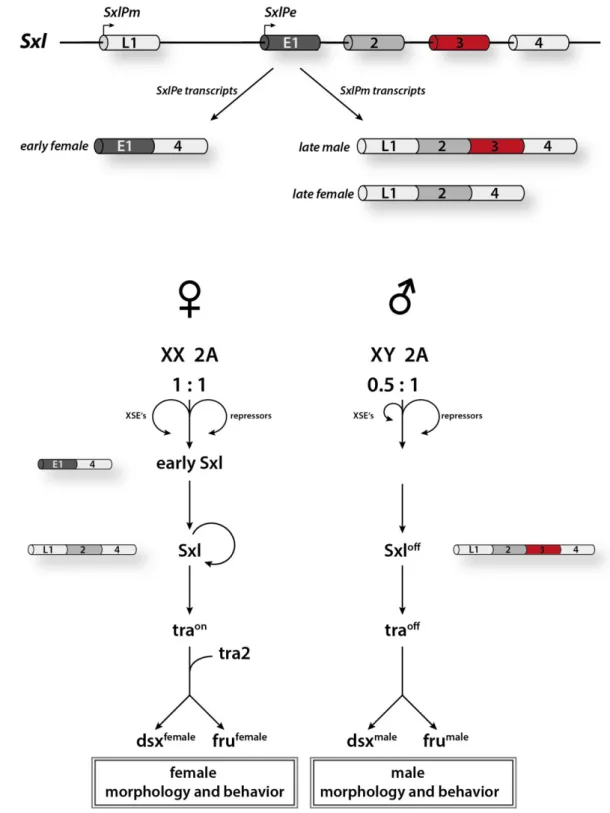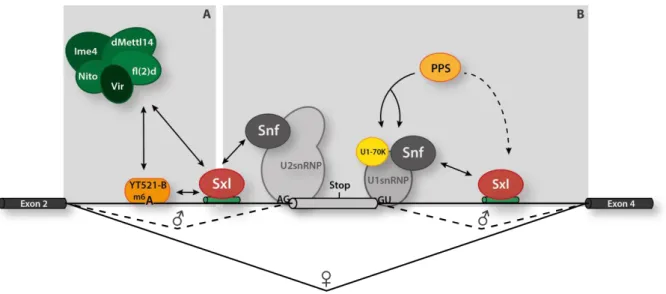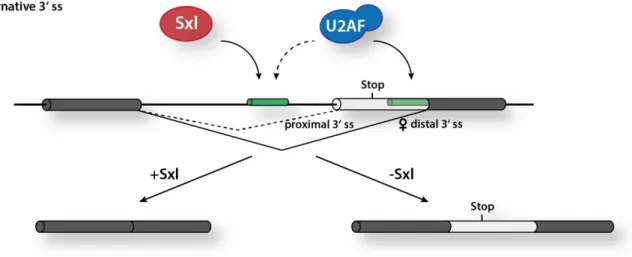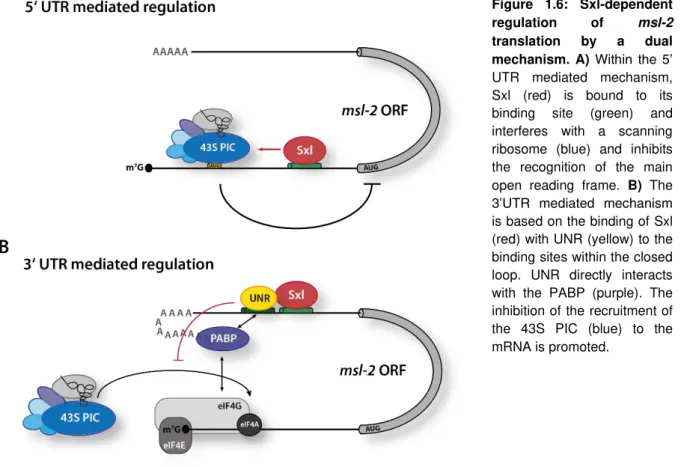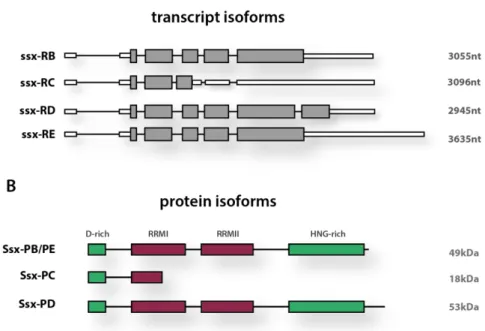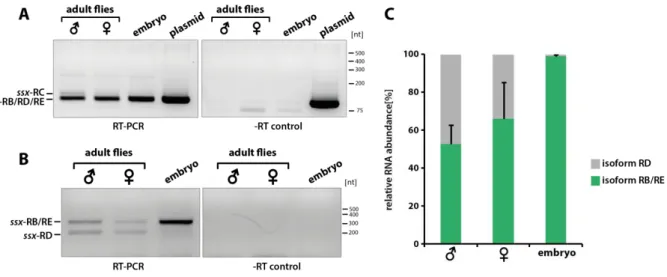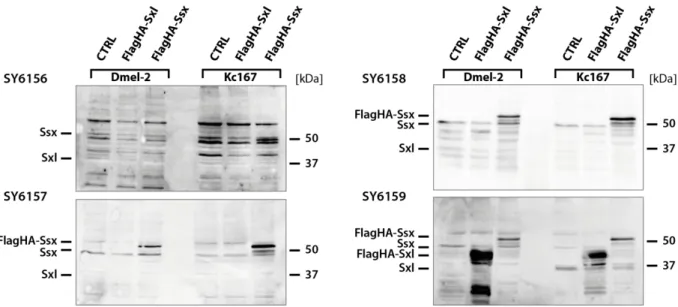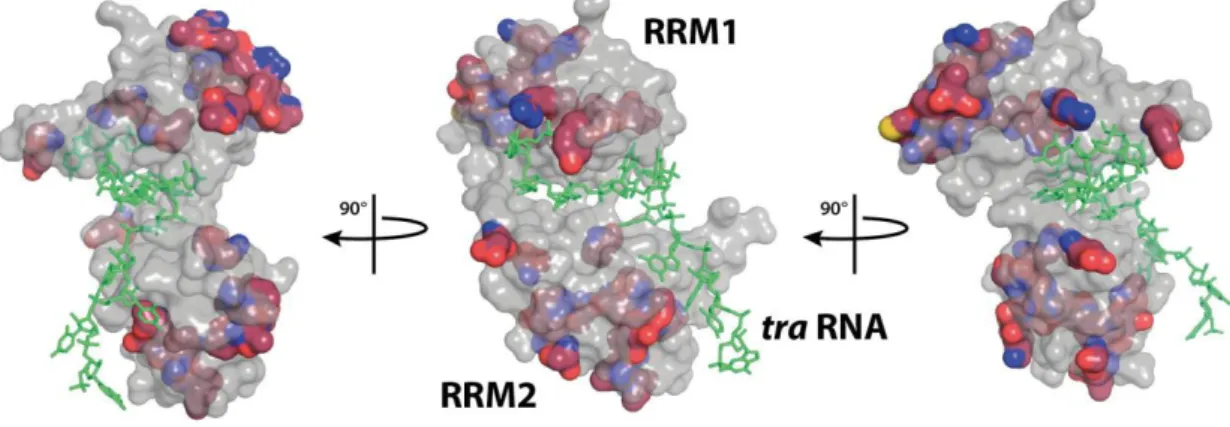Regulation of translation and alternative
splicing by the Drosophila RNA-binding protein Sister-of-Sex-lethal
DISSERTATION
ZUR ERLANGUNG DES
DOKTORGRADES DER NATURWISSENSCHAFTEN (DR. RER. NAT.) DER FAKULTÄT FÜR BIOLOGIE UND VORKLINISCHE MEDIZIN
DER UNIVERSITÄT REGENSBURG
Vorgelegt von Rebecca Moschall
aus Würzburg
Im Jahr 2018
Das Promotionsgesuch wurde eingereicht am: 01.03.2018
Die Arbeit wurde angeleitet von: PD Dr. Jan Medenbach
Unterschrift:
„Supercalifra gilisticexpiali
getisch“
Mary Poppins
Abstract
In Drosophila melanogaster, the protein Sxl Lethal (Sxl) is the master regulator of female development, controlling sex-specific differences in morphology, behaviour and dosage compensation. The female-specific protein is involved in a variety of posttranscriptional regulatory pathways, which have been intensively studied during the past decades. In contrast, the molecular function of its closely related paralog Sister-of-Sex-Lethal (Ssx) had not been elucidated. Despite their high sequence similarity, the two proteins exhibit surprising functional differences. Here we show that, unlike Sxl, Ssx is expressed in both sexes. Applying iCLIP analyses, we further determine the RNA targets of Ssx and demonstrate that the protein binds to an RNA sequence motif that is highly similar to the motif recognized by Sxl. Both proteins can recognize and bind to sequence elements previously shown to function in the regulation of alternative splicing and translational control.
Using two model substrates, the male-specific lethal-2 (msl-2) and Sxl RNAs, we addressed the role of Ssx in post-transcriptional regulation of gene expression and its functional interplay with Sxl.
To establish and to maintain its continuous expression in female flies, Sxl establishes an auto-regulatory, positive feedback loop by promoting constitutive splicing of its own primary transcript. Binding to several intronic RNA sequences, Sxl acts as an inhibitor of splicing that prevents inclusion of an exon with a premature termination codon in the mature mRNA. We demonstrate that Ssx can compete with Sxl for binding to these regulatory RNA elements. By this, Ssx can function as a competitive inhibitor of the Sxl auto-regulatory feedback loop in cultured cells. In line with this finding, male flies that lack Ssx protein exhibit aberrant Sxl expression.
In contrast to alternative splicing in which Ssx functions as an antagonist of Sxl function, both proteins can act as inhibitors of translation. For translational control of msl-2 mRNA, Sxl employs two previously characterized pathways that operate via binding sites in either the 5’
or 3’ UTR of the RNA. Ssx recapitulates 5’UTR-mediated translational repression, however, it does not exhibit regulatory activity when operating via the 3’UTR-mediated regulation. A thorough mutagenesis reveals that this difference in activity is based on three amino acid substitutions, allowing deep insights into the recent evolutionary history and functional diversification of the two proteins.
In sum, our studies reveal the molecular function of Ssx and unravel a surprisingly complex interplay between the two closely-related proteins in sex-specific development of Drosophila.
Zusammenfassung
Das RNA Bindeprotein Sex Lethal (Sxl) ist der Hauptregulator der weiblichen Fliegenentwicklung in Drosophila melanogaster, indem es die geschlechtsabhängige Morphologie und das Verhalten reguliert und die Dosiskompensation kontrolliert. Das Weibchen-spezifische Protein wirkt in einer Vielzahl von post-transkriptionellen Mechanismen, welche über die letzten Jahrzehnte intensiv untersucht worden sind. Im Gegensatz zu Sxl, ist die Funktion des nah verwandten Paralogs Sister-of-Sex-Lethal (Ssx) weitgehend unbekannt. Trotz ihrer hohen Sequenzähnlichkeit weisen beide Proteine große funktionelle Unterschiede auf. In dieser Arbeit zeigen wir, dass Ssx, im Gegensatz zu Sxl, in beiden Geschlechtern exprimiert wird. ICLIP Analysen identifizierten von Ssx gebundene RNAs und bestätigten, dass Ssx RNA Sequenzen bindet, die den Sxl Bindemotiven stark ähneln. Beide Proteine erkennen und binden Sequenzelemente, durch welche sie in der Regulation des alternativen Spleißens und der translationalen Kontrolle von Bedeutung sind.
Unter Verwendung von zwei Modelsubstraten, male-specific lethal-2 (msl-2) und Sxl mRNA, analysierten wir die Rolle von Ssx innerhalb der post-transkriptionellen Regulation der Genexpression und dessen funktionelles Zusammenspiel mit Sxl.
Um eine kontinuierliche Expression in weiblichen Fliegen zu garantieren, etabliert Sxl eine autoregulatorische positive Rückkopplung, welche ein konstitutives Spleißmuster des eigenen primären Transkripts gewährleistet. Dabei bindet Sxl an mehrere intronische RNA Sequenzen und verhindert als Spleißinhibitor die Inklusion eines Exons in die reife Sxl mRNA, welche sonst für ein verfrühtes Terminationskodon kodieren würde. In diesem Zusammenhang konnten wir zeigen, dass Ssx mit Sxl um die Bindung an diese regulatorischen RNA Elemente kompetitiert. Somit kann Ssx in männlichen Zellen als kompetitiver Inhibitor der Sxl autoregulatorischen Rückkopplung funktionieren. Im Einklang mit diesen Ergebnissen konnten wir ebenfalls beweisen, dass der Verlust von Ssx in männlichen Fliegen zu einer aberranten Sxl Expression führt.
Im Gegensatz zum alternativen Spleißen, in welchem Ssx als Antagonist der Sxl Funktion agiert, können beide Proteine Translation inhibieren. Sxl verfügt über zwei gut charakterisierte Mechanismen, um die Translationskontrolle von msl-2 zu gewährleisten.
Diese Regulation beruht auf Bindestellen innerhalb der 5’UTR oder innerhalb der 3’UTR der msl-2 mRNA. Ssx reprimiert die Translation innerhalb des 5’UTR vermittelten Mechanismus, zeigt jedoch keine regulatorische Aktivität innerhalb der 3’UTR vermittelten Regulation.
Detaillierte Mutageneseanalysen des Proteins ergaben, dass der Aktivitätsunterschied auf drei Aminosäuren zurückzuführen ist. Diese Erkenntnis erlaubte tiefe Einsichten in die evolutionäre Beziehung und die funktionelle Diversifikation der zwei Proteine.
Zusammengefasst konnten wir die molekulare Funktion von Ssx aufzeigen und das überraschend komplexe Zusammenspiel der zwei nah verwandten Paraloge in der geschlechtsabhängen Fliegenentwicklung darlegen.
Contents
Abstract VII
Zusammenfassung IX
Contents XI
1 Introduction 1
1.1 Sex determination and female development in humans, Caenorhabditis
elegans and Drosophila melanogaster 1
1.2 The X-chromosome counting system in D. melanogaster and early
female-specific Sxl expression 2
1.3 The transition of Sxl promoters and the determination of the sexual fate 5 1.4 Molecular dissection of the RNA-binding protein Sxl 6 1.5 Splicing of eukaryotic pre-mRNAs by the spliceosome 7 1.6 Female-specific, alternative splicing of Sxl pre-mRNA 9 1.7 The interplay of alternative splicing and methylation on Sxl pre-mRNA 10
1.8 Alternative splicing of tra pre-mRNA 12
1.9 Alternative splicing of msl-2 pre-mRNA 13
1.10 Sxl regulates alternative polyadenylation and interferes with the nuclear
export of specific mRNAs 14
1.11 Translation of mature mRNAs in eukaroytes 15
1.12 Cytoplasmic function of Sxl and translational control of the msl-2 mRNA 16 1.13 A well-balanced Sxl expression is mediated by its 3’UTR 19
1.14 Sxl-related proteins 20
1.15 How Sxl became the master regulator of sex determination 21
2 Results 23
2.1 Molecular dissection of the Sxl paralog Ssx 23
2.1.1 Ssx is a non essential protein 23
2.1.2 Ssx is expressed in females and males 24
2.1.3 Analysis of Ssx protein expression 27
2.2 Binding properties of Sxl and Ssx to RNA 31
xii CONTENTS
2.2.1 The similarities: Sxl and Ssx bind related RNA binding motifs 31 2.2.2 Sxl and Ssx compete for binding to the same target RNAs 36 2.2.3 Overexpressed Ssx does not interfere with splicing of known
Sxl targets 38
2.2.4 Loss of Ssx in male flies induces female-specific splicing of Sxl
pre-mRNA 39
2.2.5 Ssx can act as a splicing regulator of Sxl pre-mRNA 41 2.2.6 The N-terminus of Sxl is essential for the alternative splicing of
Sxl mRNA 42
2.3 A new identified Ssx binding site is located in msl-2 mRNA 44 2.3.1 Comparable binding affinities of Sxl and Ssx to the msl-2 binding
sites 44
2.3.2 Ssx is able to regulate msl-2 translational repression via the
5’UTR mechanism 45
2.3.3 Dissection of domains necessary for 3’ translational regulation 47 2.3.4 Differences in translational repressor activity correlate with the
recruitment of the co-repressor UNR 53
3 Discussion 59
3.1 The complex relationship of Sxl and Ssx 59
3.2 The complex interplay of Sxl and Ssx in Sxl mRNA splicing 59 3.2.1 Sxl promotes female-specific alternative splicing - Ssx stabilizes
the male-specific splice pattern 59
3.2.2 Sxl auto-regulatory splicing requires the N-terminal protein
domain 62
3.2.3 The role of Ssx within the fly 63
3.2.4 The influence of Ssx on sex-specific alternative splicing of other
mRNAs 65
3.3 The influence of Ssx on other co- and post-transcriptional events 66 3.4 The action spectrum of Ssx is not limited to alternative splicing 67
3.4.1 Evolutionary development of Ssx 67
3.4.2 Ssx act as a translational repressor of msl-2 67
3.5 Comparison to ELAV proteins 70
3.6 The advantage of Ssx 71
4 Material 73
4.1 Chemicals and enzymes 73
4.2 Kits, membranes and reagents 73
4.3 Buffer and Solutions 74
4.4 DNA and RNA Oligonucleotides 78
4.4.1 DNA oligonucleotides for cloning 78
4.4.2 DNA oligonucleotides for quantitative real time PCR 80
xiii CONTENTS
4.4.3 DNA oligonucleotides for RT-PCR 80
4.4.4 RNA oligonucleotides for electro mobility shift assay 81
4.5 Plasmids 81
4.6 Antibodies 82
4.7 Bacterial strains, D. melanogaster cell lines, D. melanogaster strains 82
4.7.1 Bacterial strains 82
4.7.2 Cell lines 82
4.7.3 Fly alleles 83
5 Methods 85
5.1 Molecular biological methods 85
5.1.1 General methods 85
5.1.2 Molecular cloning 85
5.1.2.1 Polymerase chain reaction (PCR) and overlapping
(PCR) 85
5.1.2.2 Restriction digest 86
5.1.2.3 Ligation and transformation of E. coli 86 5.1.2.4 Extraction of plasmid DNA from E. coli and
sequencing 87
5.1.2.5 Generated DNA plasmids 87
5.1.3 RNA-based methods 88
5.1.3.1 RNA isolation 88
5.1.3.2 DNase digestion, reverse transcription and RT-PCR
for splice pattern analysis 89
5.1.3.3 Quantitative RT-PCR 89
5.1.3.4 In vitro transcription 90
5.1.3.5 Probe labeling 90
5.2 Tissue culture methods 90
5.2.1 Cell culture 90
5.2.1.1 Transfection using FugeneHD 90
5.2.1.2 Knockdown via dsRNA 91
5.2.1.3 UV-crosslinking of Dmel-2 cells 91
5.2.1.4 In vivo luciferase assay 91
5.3 Biochemical methods 91
5.3.1 SDS PAGE, Coomassie staining and Western Blot 91
5.3.2 RNA-Immunoprecipitation (RIP) 93
5.3.3 Individual-nucleotide resolution crosslinking-immuno-
precipitation (iCLIP) 94
5.3.4 Expression and purification of recombinant proteins 95 5.3.4.1 Purification of Sxl RBD4, Ssx RBD4 and mutations
thereof 95
5.3.4.2 Purification of UNR-CSD1 95
5.3.5 Electro-mobility-shift-assays (EMSA) 96
5.3.6 In vitro luciferase assay 96
xiv CONTENTS
5.4 Fly genetics 97
5.4.1 Maintaining fly stocks and breeding conditions 97
5.4.2 Generation of transgenic fly lines 97
5.4.2.1 PhiC31 integrase system 97
5.4.2.2 CRISPR/Cas9 system 98
5.4.2.3 Injection of embryos 98
5.4.2.4 UAS::GAL4 system 98
5.4.3 Lethality assay 99
Appendix 101
List of Figures 105
List of Abbreviations 107
References 111
Publications and Presentations 125
Contributions 127
Danksagung 129
1 Introduction
1.1 Sex determination, dosage compensation and female development in humans, Caenorhabditis elegans and Drosophila melanogaster
At the time of early developmental stages in most organisms from flies to humans an important decision has to be made: whether to be male or female. This decision has to be tightly regulated and evolution achieved a colorful spectrum of mechanisms to solve this task. In general, three main ways of sex determination are found in nature: hermaphroditism, sex determination by environmental influences and genotypic sex determination (Bachtrog et al. 2014). While e.g. clownfish start life being a male and exclusively the most dominant animal in the hierarchy develop into a female over time (sequential hermaphrodites) (Munday et al. 2006) many flowering plants harbour both, female and male organs (simultaneous hermaphrodites) (Renner and Ricklefs 1995). In other organisms, such as e.g. turtles and crocodiles, sex determination is governed by environmental factors such as temperature during embryonic development with higher temperatures producing more females and lower temperatures more males. Both are genetically identical without the necessity of sex specific chromosomes and dosage compensation (reviewed in Crews 2003; Lance 2009).
In contrast, higher organisms mostly employ genetic sex determination which coincides with different sex chromosomes counts (XX vs. XY) which consequently leads to gene dose imbalances. To overcome this problem, different organisms have evolved a variety of strategies to adjust the gene dose between the sexes. Humans, Caenorhabditis elegans (C.
elegans) and Drosophila melanogaster (D. melanogaster) employ different strategies. Sex determination in humans makes use of the Y-chromosome encoded regulator SRY: this protein promotes the development of male testis, whereas its absence results in the formation of ovaries (Sinclair et al. 1990). The resulting gene dose imbalance between males and females is compensated in females by random inactivation of one of the two X chromosomes (Okamoto et al. 2011). X-inactivation is mediated by the long non-coding RNA Xist which is exclusively expressed from the inactive X chromosome. The Xist RNA acts in cis and coats the major part of the inactive X chromosome to promote hypoacetylation of histones and methylation of promoters, which finally results in the formation of heterochromatin and a highly condensed chromosome, the Barr body (reviewed in Payer and Lee 2008).
2 1. INTRODUCTION
Analogous to humans, the roundworm C. elegans expresses a male specific protein (Xol-1) to define the male state and to ensure dosage compensation. In C. elegans sex determination relies on a X chromosome counting system, with XX animals developing into hermaphrodites and XO into males. In XX animals, dosage compensation is achieved by reducing the gene expression from each X chromosome by one half. This female specific down regulation of gene expression is mediated by the dosage compensation complex (DCC). DCC expression in males is prevented through repression of its limiting component sdc-2 by Xol-1 (reviewed in Lucchesi et al. 2005; Ercan and Lieb 2009).
In contrast to C. elegans, dosage compensation in D. melanogaster is achieved by the hyper-transcription of the single male X chromosome which has to be prevented in females.
Again, sex specific regulation is achieved by the sex-specific expression of a dosage compensation complex active in chromatin remodeling. In female flies, DCC formation is repressed by the multifunctional protein Sex lethal (Sxl) that is produced by a mechanism that is sensitive to the number of X chromosomes. Functional protein is expressed in females, while it remains unexpressed in males.
1.2 The X-chromosome counting system in D. melanogaster and early female-specific Sxl expression
The role of Sxl as the master regulator is unique for the species of D. melanogaster (Sawanth et al. 2016). In other flies, the protein Transformer (Tra) usually is at the top of the developmental cascade (Traut et al. 2006; Salz 2011). In D. melanogaster instead, the developmental cascade is initiated by Sxl which regulates a variety of downstream targets, committing to female development. In females, alternative splicing of tra is under control of Sxl. Functional Tra protein is only expressed in females where it dimerizes with the ubiquitously expressed Tra2 protein and this heterodimer controls the alternative splicing of its target mRNAs doublesex (dsx) and fruitless (fru), leading to female specific splice patterns. The proteins Dsx and Fru represent two important key regulators involved in the development of the central nervous system as well as the somatic sexual differentiation (Fig.
1.1 B). Depending on their isoforms, they promote the establishment of female or male morphology and behavior (reviewed in Penalva and Sanchez 2003). But how is sex-specific expression of functional Sxl protein achieved?
The Sxl gene harbours two promoters, SxlPe and SxlPm, which are strictly regulated in time.
The establishment promoter SxlPe functions as the initiation promoter acting in a short time window ending at the cellular blastoderm stage and is switched on exclusively in females (Parkhurst et al. 1990; Keyes et al. 1992). When entering the next developmental stage, the promoter SxlPe is inactivated and Sxl is transcribed from the maintenance promoter SxlPm releasing a slightly different transcript (Bell et al. 1988; Salz et al. 1989). While the SxlPe
1. INTRODUCTION 3
promoter is switched on exclusively in females, the maintenance promoter SxlPm is constitutively active in both sexes (Fig. 1.1 A). Within this chapter, we will first focus on the transcription from the SxlPe promoter, while the transcription from SxlPm and the processing of its transcripts is described in chapter 1.3 and chapter 1.6.
The activation of the SxlPe promoter and thus the decision of becoming a female is dependent on the expression levels of four X-linked signal elements (XSE), which are encoded on the X chromosome. These proteins, namely scute (SisB), runt, sisA and unpaired (SisC) are directly translating the two-fold X chromosome dose in females into the transcriptional activation of Sxl from SxlPe promoter (Cline 1988; Duffy and Gergen 1991;
Keyes et al. 1992; Sanchez et al. 1994; Jinks et al. 2000; Sefton et al. 2000). While the X chromosomes encode transcriptional activators for Sxl expression, autosomes harbour negative regulators of Sxl transcription; Groucho, extramachrochetae (Emc) and deadpan (dpn) (maternally or zygotically provided) (Youngershepherd et al. 1992; Paroush et al. 1994;
Barbash and Cline 1995). The final ratio with a two-fold difference of activator vs. repressor protein levels, which is determined by the X chromosomal dose (XX=1:1; XY=0.5:1), translates this fine-tuned balance of regulators into an ON/OFF signal for Sxl expression from the SxlPe promoter (Figure 1.1 B). When the dose of transcriptional activators in females overcomes the autosomal expression of repressors, SxlPe is activated and Sxl expression is initiated. This later on leads to the establishment of a positive auto-regulatory feedback loop of Sxl and finally ends in the development of female flies (reviewed in Salz and Erickson 2010).
4 1. INTRODUCTION
Figure 1.1: Overview of the sex determination cascade within the development of D. melanogaster.
A) Sxl transcription from the Sxl early promoter SxlPe and Sxl maintenance promoter SxlPm results in different transcripts. Sxl early female transcripts are transcribed from SxlPe promoter while Sxl late female and Sxl late male transcripts are generated from the promoter SxlPm. B) Expression of functional Sxl protein is regulated by an X chromosome counting mechanism. In females, XSE proteins activate the early Sxl transcription by competing with autosomal supplied repressor proteins, boosting the developmental cascade.
Expression of early Sxl protein in females is followed by the expression of Sxl from SxlPm transcripts. Tra protein translated from functional spliced tra mRNA in females induces female-specific splicing of dsx and fru. In males, autosomal repressors overcome the amount of XSE lacking early Sxl expression. This triggers male- specific splicing of the effector targets dsx and fru, inducing to male traits.
1. INTRODUCTION 5
With the exception of the protein Unpaired which acts as a ligand in the Jak/Stat pathway (Sefton et al. 2000), all XSE proteins belong to a family of transcriptional regulators.
Unpaired influences Sxl transcription by activating the maternally supplied transcriptional activator Stat92E (Jinks et al. 2000; Sefton et al. 2000; Avila and Erickson 2007).
Furthermore, a heterodimer consisting of the bZip transcription factor SisA and the AML1-like transcription factor Runt is known to interact and directly activate SxlPe (Erickson and Cline 1993; Kramer et al. 1999). In addition, Scute (a bHLH-transcription factor) together with the maternally supplied Daughterless (Da) protein recognize non-canonical binding sites in SxlPe and further trigger Sxl transcription (Yang et al. 2001). In order to translate the proper XSE dose in an all-or-nothing response to SxlPe, autosomally supplied (equally expressed in males and females) transcriptional repressors interfere with the activity of XSE proteins.
The maternally supplied repressor Emc is a member of the HLH proteins and preferentially forms heterodimers with bHLH activators like Scute or Daughterless, preventing their binding to DNA promoter sequences (Massari and Murre 2000; Campuzano 2001). Since the influence of Emc on dosage compensation is rather limited (Youngershepherd et al. 1992), Groucho is considered to be the major repressor of early Sxl transcription. It was demonstrated that Groucho translates the dose of XSE into an all-or-nothing response since the lack of maternally supplied Groucho leads to an expression of SxlPe in both sexes proportionally to their XSE dose (Lu et al. 2008). The amplification of the XSE dose by Groucho is implemented by its interaction with Dpn, a DNA binding protein which is also able to negatively regulate SxlPe. While in females XSE proteins overcome the negative regulation by the Groucho and Dpn complex ending in an overall amplification of Sxl transcripts from SxlPe, in males the Groucho-Dpn heterodimer successfully competes with XSEs for binding to the promoter regions and prevents Sxl transcription (Paroush et al. 1994; Lu et al. 2008).
1.3 The transition of Sxl promoters and the determination of the sexual fate The transition from the early SxlPe promoter to the housekeeping promoter of Sxl, SxlPm is tightly regulated and far more complex than initially thought. It was demonstrated that transcription from SxlPm is activated within cycle 13 in female embryos and is overlapping for a short period with the remaining activity of SxlPe. Male embryos instead are delayed in the onset of SxlPm transcription which is first detected approximately 10 minutes later in the early cycle 14 (Gonzalez et al. 2008). This female-first pattern can be explained by the differing dose of the XSEs Runt and Scute and the maternally provided Daughterless which are not exclusively involved in activating SxlPe but also in directly promoting the initial SxlPm response. SxlPe and SxlPm share a common enhancer element and since females express twice the dose of XSE, this forces earlier transcription from the SxlPm promoter in females
6 1. INTRODUCTION
compared to males (Gonzalez et al. 2008). As a result, the early female accumulation of SxlPm transcripts together with early Sxl protein guarantee efficient amplification of functionally spliced Sxl transcripts and forces the female development. Furthermore, in rare cases due to fluctuations in XSE amounts, low levels of Sxl protein could be mistakenly produced in males. This robust and temporary controlled fail-safe mechanism ensures that erroneously expressed early Sxl protein would not regulate splicing of SxlPm transcripts and thus preventing accumulation of Sxl proteins in male embryos (Gonzalez et al. 2008).
Entering the maintenance phase, the initial Sxl burst in females is amplified to a robust and life-lasting expression of Sxl protein. With that, the transcriptional regulation of SxlPe promoter is changed to a control at splicing level from SxlPm transcripts, in which the positive auto-regulatory feedback loop of Sxl protein triggers the alternative splicing of its own transcript (Cline 1984; Bell et al. 1991).
1.4 Molecular dissection of the RNA-binding protein Sxl
Despite its variety of functions, Sxl surprises with a rather simple protein architecture. The central domain of the protein comprises of two RNA recognition motifs (RRM) that are flanked by a N-terminal glycine-rich region and a C-terminal proline-rich region. The RRMs mediate binding to U-rich or UG-rich RNA sequences of at least seven nucleotides in length (Sosnowski et al. 1989; Kanaar et al. 1995). Oligomerization through the glycine-rich N- terminal region stabilises RNA binding. In addition, the N-terminal domain of Sxl participates in numerous interactions with different binding partners. In contrast, the function of the C- terminal part remains elusive (Wang et al. 1997). Sxl has versatile functions within the fly, since it is able to bind efficiently to RNA and interacts with specific protein partners. These skills enable Sxl to adapt to a respective mechanism, in which the protein can then act as promoter, inhibitor or fine-tuner. In females, Sxl is ubiquitously expressed and predominantly localized in the nucleus but due to its shuttling ability the protein can be exported. The localization pattern of Sxl within the germline is more dynamic. First, Sxl is mainly localized within the cytoplasm, peaking in cystoblasts and 2-cell stage of the germarium. Afterwards, a diffuse and low-level Sxl expression is detected in 4-16 cell cysts, while elevated and nucleic levels of Sxl protein were detected again at later stages (Bopp et al. 1991; Bopp et al. 1993).
Moreover, the RNA binding protein Sxl is involved in a great number of posttranscriptional regulation pathways, ranging from splicing control to translational control. The following chapters will focus on the role of Sxl within each step of posttranscriptional regulation of its various target mRNAs.
1. INTRODUCTION 7
1.5 Splicing of eukaryotic pre-mRNAs by the spliceosome
Splicing is a fundamental step in posttranscriptional gene regulation, in which exons are joined together. The splicing mechanism is highly dynamic and connects the accuracy of splice site recognition with the flexibility of splice site choice. Intronic regions are normally defined by three core splicing signals; the 5’splice site (5’ss), 3’splice site (3’ss) and a branchpoint which is located upstream of the 3’ss in its close proximity (18-40nt) and is next to a polypyrimidine tract (PPT) (Burge et al. 1999). The spliceosome assembles on the intron (Fox-Walsh et al. 2005) which is excised from the pre-mRNA by two constitutive transesterification reactions. Here, the free 2’OH group of the branchpoint adenosine attacks the phosphate group of the 5’ss guanosine (in rare cases also other than G are recognized), generating a 2’-5’ phosphodiester bond. This is followed by a second transesterification step, during which the free hydroxyl group of the 5’ss attacks the phosphodiester bond of the 3’ss.
This joins the two exons and releases the intron in form of a lariat structure (reviewed in Will and Lührmann 2011). Pre-mRNA splicing is (with few exceptions) catalyzed by the spliceosome, a multi-megadalton ribonucleoprotein complex, consisting of in total four small nucleolar ribonucleoprotein (snRNP) complexes (U1, U2, U5 and U4/U6 snRNPs) in case of the major spliceosome and several non-snRNP proteins. Each snRNP itself is composed of one snRNA (two in the case of U4/U6 snRNP) complexed with seven Sm proteins (B/B’, D3, D2, D1, E, F and G) or Sm-like proteins (reviewed in Will and Lührmann 2011) and other additional proteins. For assembly of the spliceosome, the 5’ss and the branch point sequence are recognized by the U1 and U2snRNPs and their associated proteins. Initially, U1snRNP recognizes the 5’ss while the splice factor 1 (SF1) binds the branch point sequence (BPS) and the U2 auxiliary factor (U2AF, composed of the two subunits U2AF65 and U2AF35) is recruited to the PPT, generating the E-complex. Furthermore, the small subunit U2AF35 recognizes the AG of the 3’ss and is tightly bound with U2AF65 in a heterodimer. This reaction is followed by the base-pairing of U2snRNA with the BPS (A- complex), which is promoted and stabilized by other components of U2snRNP (SF3a and SF3b and the RS-rich domain of U2AF65). After reorganization of the A-complex, including the displacement of SF1 from the BPS, the trisnRNP, consisting of the preassembled U5 with U4/U6 snRNP, is guided to the A-complex, generating the pre-catalytic B-complex. Extensive remodeling of RNA-protein and RNA-RNA interactions results in destabilization and release of the U1 and U4snRNP (Bact-complex). Subsequent activation by the RNA helicase Prp2 generates the B*-complex. Prp2 stimulates the first transesterification step leading to additional rearrangements (C-complex) promoting the second nucleophilic attack. Finally, the spliceosome disassembles and the snRNPs are recycled (reviewed in Wahl et al. 2009; Will and Lührmann 2011).
8 1. INTRODUCTION
Besides the canonical, constitutive splicing of mRNA, the majority of mRNAs is alternatively processed (Johnson et al. 2003; Modrek and Lee 2002). Constitutive splicing generates a single mature mRNA species. In contrast, alternative splicing generates a great variety of different splicing products. This can result in a large number of protein isoforms which can originate from one precursor transcript (Nilsen and Graveley 2010). Alternative splicing events are grouped in several major forms shown in Fig. 1.2: exon skipping, intron retention, alternative 5’ splice site and alternative 3’ splice site, alternative terminal exons and mutually exclusive exons (Kan et al. 2002; Wang and Burge 2008). The recognition of splice sites is regulated by enhancer and silencer sequences, located within the intron or the exon sequence. They help to define the exon intron border in alternative spliced transcripts but also in constitutively spliced transcripts. The principal aim of exonic splice enhancers (ESE) is the recruitment of proteins usually of the SR family. Hence, the interactions of SR proteins with respective spliceosomal components promote an efficient spliceosome assembly, even in the case of rather weak splice site sequences. Exonic and intronic splicing silencer (ESS and ISS) are often recognized by members of heterogeneous nuclear ribonucleoprotein family (hnRNPs), which act as splicing repressors and interfere with splicing by various mechanisms. For instance, the protein hnRNP I competes with U2AF for binding. In contrast, the silencing activity of hnRNP A1 is varying depending on the sequence context. The protein is able to interfere with the binding of SR proteins but also with the binding of U1 and
Figure 1.2: Overview of alternative splicing patterns. Alternative splicing events can occur individually, while also a combination of two alternative splicing events is possible.
1. INTRODUCTION 9
U2snRNP to the splice sites (reviewed in Wang and Burge 2008; Matlin et al. 2005). In general, the definition of hnRNPs is rather broad. They are defined by containing one or more RNA binding domains (RRM-like, KH-like or RGG-like). In addition, the majority of hnRNPs contain auxiliary domains, such as proline-, glycine- or acid-rich domains which are often linked to splicing inhibitory activities (Geuens et al. 2016). In this view, the domain architecture of Sxl, which contains an N-terminal glycine-rich region and two RRM domains strongly resembles the members of the hnRNP family (Matlin et al. 2005). The activity of Sxl as a splice silencer requires a defined sequence context within the regulated mRNAs. In addition, Sxl mediates a fine-tuned regulation of alternative splicing by acting in concert with different co-factors and competitors. The following paragraphs will describe the great variety of interactions in which the protein Sxl is involved to fulfill its function as the major regulator of female development.
1.6 Female-specific, alternative splicing of the Sxl pre-mRNA
To establish its continuous expression in female flies, Sxl regulates alternative splicing of its own primary transcript. It interferes with the inclusion of the male-specific exon 3, referred to as the poison exon because it harbours a premature stop codon. In males, exon 3 is included in the Sxl mRNA, resulting in the expression of a truncated, nonfunctional Sxl protein (2-3-4). In contrast, in females, skipping of exon 3 and the joining of exon 2 with exon 4 results in production of a functional full-length Sxl protein (2-4). The control of Sxl mRNA splicing is far more complex than previously expected, and many protein interaction partners support Sxl in regulation. The hotspots within the Sxl mRNA which are bound by several Sxl proteins are located approximately 200 nucleotides upstream and downstream of the poison exon (Horabin and Schedl 1993a; Horabin and Schedl 1993b). Once the protein has recognized its binding sites, Sxl is able to interact with components of the U1snRNP and U2snRNP. However, Sxl does not act by simply displacing the U1snRNP from the 5’ss splice and its impact on splicing is based on a variety of interactions with several other splicing components (Johnson et al. 2010). One of these factors is Sans fille (Snf), which shares a high degree of homology with the mammalian proteins U1A and U2B`` (Samules et al. 1998;
Flickinger and Salz 1994; Harper et al. 1992). Both proteins, Sxl and Snf, directly interact with their RRM domains independently of wether Snf is complexed with U1snRNP or not (Nagengast 2003). Interestingly, some mutations within Snf lead to the disruption of the Sxl auto-regulatory splicing cascade (Bopp et al. 1993; Albrecht and Salz 1993; Salz and Flickinger 1996). Besides Snf, also another protein component of the U1snRNP, namely U1- 70K, is known to become essential for Sxl splicing in a sensitized background of low Sxl and Snf levels (Nagengast 2003). In addition to the stable complex formation between U1snRNP, Sxl and Snf, the transcription factor homolog protein partner of sans fille (PPS) was also
10 1. INTRODUCTION
found to be associated with the Sxl mRNA, whereas its function remains to be elusive (Johnson et al. 2010). This example nicely demonstrates the robustness of the Sxl splicing cascade in which redundant interactions ensure exon skipping and therefore guarantee female-specific Sxl expression (Fig. 1.3 B). Moreover, Snf does not contribute to splicing only by its interaction with the U1snRNP, but it has been also described as a component of the U2snRNP (Harper 1992). By that, a similar interaction of Sxl and Snf in the context of the U2snRNP could be possible as well.
1.7 The interplay of alternative splicing and RNA methylation on the Sxl pre- mRNA
Sxl autoregulatory splicing also depends on several proteins that are involved in RNA methylation. The protein Vir was first described in 1995 to promote the sex-specific splicing of Sxl. The absence of Vir was shown to lead to female-specific lethality in flies (Hilfiker et al.
1995). A second protein, namely Fl(2)d was also described to interact directly with Sxl protein and to promote Sxl sex-specific splicing: a loss of function mutation led to a male- specific splice pattern (Granadino et al. 1996). After two decades of research, these two proteins were identified as important components of the methyltransferase complex in D.
melanogaster. The methylation marks introduced by this RNA m6A methyltransferase complex were shown to be necessary for the sex-specific splicing of Sxl mRNA and of other transcripts (Lence et al. 2016; Haussmann et al. 2016). In general, the complex methylates
Figure 1.3: Alternative splicing of Sxl pre-mRNA is regulated by the Sxl protein. (A) Female-specific splicing of Sxl pre-mRNA is promoted by methylation marks in close proximity to Sxl binding sites. Methylation sites are modified by the METTL complex consisting of Ime4, dMettl14, Nito, Virilizer (Vir) and Fl(2)d (green).
The modification is recognized by the reader protein YT521-B (orange) which is also directly interacting with Vir (dark green) and Sxl (red). This interaction network enforces the female-specific splicing pattern. (B) Sxl splicing is regulated by the Sxl protein which directly interferes with spliceosomal components of U1snRNP (grey) and U2snRNP (grey) and finally promotes female-specific exon skipping.
1. INTRODUCTION 11
adenosines (embedded in RRACH motifs; A methylated A; R=purine; H=A, C or U) at the N6 position. By that, RNAs are marked for subsequent steps of post-transcriptional RNA processing, like pre-mRNA splicing or decay (Meyer et al. 2012). In mammals, recent findings indicate that mRNA modifications are associated with enhanced cytoplasmic mRNA turnover rather than pre-mRNA splicing (Ke et al. 2017). However, in Drosophila m6A RNA methylation is mainly linked to alternative splicing. This finding is supported by the fact that the absence of m6A results in an overall change in alternative splice patterns in 2% of all transcripts. Among them, a bias of 75% was observed for alternative splicing events occurring within 5’UTRs (Lence et al. 2016; Haussmann et al. 2016).
The composition of the methyltransferase complex strongly resembles the orthologs of the human complex, which is composed of METTL3, METTL14, and WTAP which correspond in D. melanogaster to Ime4, dMETTL14 and Fl(2)d, respectively. Other associated proteins are KIAA1429, the ortholog of Vir and RNA-binding motif protein 15 (RBM15), which is known in flies as Spenito (Fig. 1.3 A) (Lence et al. 2016; Haussmann et al. 2016, Liu et al. 2015;
Horiuchi et al. 2013; Wang et al. 2016a; Wang et al. 2016b). In general, the effects of a single knockout of individual components of the METTL complex are rather mild in flies compared to mammals. Although flies are still viable, they show defects in locomotion, in their behavior and their lifespan is reduced. The fact that the m6A methylation of the Sxl mRNA and its splicing are tightly linked becomes apparent when looking at Sxl splice patterns in fly strains depleted of components of METTL complex. The knockout of Ime4 shifts the Sxl splicing pattern towards the male-specific transcript isoforms in females, but the flies are viable. In contrast, an Ime4 knock out in a heterozygous Sxl background leads to female-specific lethality, whereas males remain unaffected. This supports the hypothesis that the splicing reaction is dependent on Sxl binding and also depends on methylation marks in close proximity to the respective Sxl binding sites (Lence et al. 2016; Haussmann et al.
2016). M6A modifications on the mRNAs are recognized by specialized reader proteins.
While in mammals five members of two subfamilies have been characterized (YTHDC1/2, YTHDF1/2/3) (Roignant and Soller 2017), only two reader proteins, YT521-B and CG6422, were identified in D. melanogaster. Of note, the impact of the m6A methylation on dosage compensation and locomotion is mainly linked to the activity of the nuclear reader protein YT521-B, while the influence of CG6422 is rather limited in this context (Lence et al. 2016).
Intriguingly, YT521-B is involved in Sxl splicing, as its knock out induces male-specific splicing pattern in females. Moreover, forced overexpression of YT521-B was found to be associated with male lethality but can be rescued by the deletion of Ime4 (Lence et al. 2016;
Haussmann et al. 2016). Until today, it remains to be determined how exactly YTH proteins behave when they recognize the m6A-modified mRNA and if a celltype- and transcript-
12 1. INTRODUCTION
specific recognition is facilitated by interactions with specific RNA binding proteins, such as Sxl or Ssx (Lence et al. 2016) or other Hu-related proteins (Lence et al. 2017).
1.8 Alternative splicing of the tra pre-mRNA
The development of female morphology and behavior is mostly followed by the expression of tra which is under the control of Sxl. Female Tra protein in here pairs up with the ubiquitous expressed Tra2 protein and promotes the production of a female-specific isoform of the transcription factor dsx and fru that drive female development.
Once female Dsx and Fru protein versions are expressed, these transcription factors guide fundamental steps in fly development defining the female identity characterized by the appropriate morphology and behavior (Lopez 1998; Graveley 2002; Penalva and Sanchez 2003; Salz and Erickson 2010; Salz 2011). Similarly to Sxl, also tra transcripts are produced in both sexes, whereby a functional transcript variant is exclusively processed in females.
The production of Tra protein in female flies is regulated by Sxl on the level of splicing, suppressing the proximal 3’ss and directing splicing to a distal site further downstream. In the tra mRNA, intron 1 harbors two alternative 3’ splice sites, while the PPT of the proximal 3’ss has an approximately 100-fold higher affinity for the heterodimeric splicing factor U2AF.
Usage of the proximal 3’ss results in the inclusion of a premature termination codon which subsequently leads to the translation of a truncated, non-functional protein in males (Valcarcel et al. 1993). In females, Sxl has a high binding affinity exclusively for the proximal 3’ss, while U2AF is, in theory, able to interact with both PPTs to a similar extent. This results in the competition between Sxl and U2AF at the favored proximal 3’ss and ultimately shifts the binding of U2AF towards the weaker distal 3’ss. Consequently, the U2snRNP is recruited to the distal 3’ss which gives rise to a spliced mRNA that encodes for the functional, full- length Tra protein (Fig. 1.4) (Sosnowaki et al. 1989; Inoue et al. 1990; Valcarcel et al. 1993).
A deletion of the first 40aa of the Sxl protein was shown to severely impair its ability to regulate Sxl and tra splicing (Wang and Bell 1994; Yanowitz et al. 1999). Sxl binds RNA motifs with its central region, hence RNA binding is not affected by the deletion of the N- terminus. Therefore, a simple competition reaction between Sxl and U2AF could be excluded. Moreover, an overexpression of the Sxl N-terminus in males showed a splicing shift towards the distal 3’ss by a yet unidentified mechanism (Desphande et al. 1999). This further demonstrates the importance of N-terminal protein-protein interactions of Sxl with not yet characterized protein partners to ensure proper tra splicing in females to trigger the female development.
1. INTRODUCTION 13
1.9 Alternative splicing of the msl-2 pre-mRNA
Dosage compensation in D. melanogaster is achieved by the hypertranscription of the single male X chromosome. In females, hyperactivation of the X-chromosomes has to be repressed in female flies to ensure equal gene doses between sexes (reviewed in Conrad and Akhtar 2012). The hypertranscription is mediated by the DCC, with Msl-2 protein as the limiting component which is not expressed in female flies. This strict control of msl-2 expression is achieved by several mechanisms acting at different post-transcriptional levels (Bashaw and Baker 1997; Gebauer et al. 1998; Kelley et al. 1997). In contrast to the fail-safe regulation of Sxl expression, which is exclusively based on alternative splicing, robustness in the regulation of msl-2 expression is achieved by the interplay of several processes. These comprise the regulation of alternative splicing, mRNA export and translational control. The central function of Sxl in these pathways will be discussed separately in the following chapters.
First of all, sex-specific, alternative splicing of msl-2 is necessary in females to include the facultative 5’UTR intron which harbours Sxl binding sites for translational regulation.
Alternative splicing regulation of msl-2 is based on the competition between the Sxl and the heterodimeric splicing factor U2AF resulting in intron retention. Consequently, female- specific transcripts harbor additional 133nt within their 5’UTRs compared to their male counterparts (Fig. 1.5) (Zhou et al. 1995; Bashaw and Baker 1997; Merendino et al. 1999;
Yanowitz et al. 1999). Similarly to the tra transcripts (see chapter 1.8), msl-2 transcripts contain two U-stretches in the intronic region in close proximity of the respective 5’ and 3’ss (Gebauer et al. 1998; Forch et al. 2001). One of these U-stretches is embedded in the PPT and is recognized by U2AF65. However, due to the relative long distance between the 3’ss
Figure 1.4: Sxl regulates the alternative 3’ss usage in the tra pre-mRNA. Here, Sxl (red) competes with U2AF (blue) for binding to the proximal PPT (green) and forces binding of U2AF to the distal PPT (light green) resulting in the female-specific splicing of the tra mRNA.
14 1. INTRODUCTION
and the intronic PPT, the interaction between U2AF35 and the 3’ss cannot be established.
This weakens the binding affinity of U2AF65 to the RNA. This weakness is exploited by Sxl which efficiently competes with U2AF for binding and thereby stimulates intron retention in the msl-2 mRNA (Merendino et al. 1999). In addition to the competition with U2AF, Sxl interferes with TIA-1 (Rox8 in D. melanogaster) for binding to the corresponding U-stretch at the 5’ss within the 5’UTR of msl-2 (Fig. 1.5). Rox8/TIA-1 normally promotes binding of the U1snRNP to the 5’ss (Del Gatto-Konczak et al. 2000; Forch et al. 2000). Thus, competition between Sxl and TIA-1/Rox8 prevents recruitment of the U1snRNP and hinders the removal of the 5’UTR intron (Förch et al. 2001). In sum, together with different co-factors Sxl promotes the inclusion of the 5’UTR intron in the msl-2 mRNA to ensure efficient downregulation of msl-2 expression.
1.10 Sxl regulates alternative polyadenylation and interferes with the nuclear export of specific mRNAs
Besides splicing, the alternative polyadenylation of mRNAs is an additional regulatory mechanism that determines the fate of mRNAs. In general, poly(A) tails are an important feature to be later on recognized by the nuclear export machinery and they can further influence the translational efficiency. Importantly, Sxl was shown to influence the poly(A) site choice of the enhancer of rudimentary (e(r)) mRNA in the female germline. Here, alternative poly(A) site choice of e(r) mRNA is established by a competition between Sxl and CstF-64 for binding to the proximal, male-specific poly(A) signal. This competition and the switch in poly(A) site choice results in the production of an extended, female-specific transcript wich exhibits a reduced translation efficiency (Gawande et al. 2006). The impact of Sxl on co- and
Figure 1.5: Intron retention in the 5’UTR of the msl-2 mRNA is promoted by Sxl. Sxl (red) competes with Rox8/TIA (yellow) and U2AF (blue) for binding to U-rich sequences (green) at the 5’ss and 3 ss, respectively. By that, Sxl forces alternative splicing of msl-2 leading to intron retention in female flies.
1. INTRODUCTION 15
post-transcriptional processing events is not limited to alternative polyadenylation. In addition, Sxl prevents together with the protein Held out wings (How) the nuclear export of the msl-2 mRNA.
Alternative splicing of msl-2 is followed by the nuclear retention of msl-2 transcripts. Here, the retained 5’UTR intron harbors two U-stretches which are bound by Sxl, while additional flanking sequences were shown to be bound by the How protein. Sxl and How interact directly with each other and can bind independently to the msl-2 mRNA. Together, they retain the transcript in the nucleus, while the detailed role of Sxl in the msl-2 mRNA export needs further investigation. Moreover, the molecular details of this mechanism and the potential involvement of further interactors still remain to be clarified (Graindorge et al. 2013).
1.11 Translation of mature mRNAs in eukaryotes
In the cytoplasm, mRNAs serve as templates for the translation of proteins. Compared to the post-transcriptional control of gene expression, translational regulation enables the most rapid changes in protein abundance, allowing an efficient adaption of the protein levels to specific requirements. Basically, the translation of an mRNA depends on the molecular features which were added during the maturation of pre-mRNAs: A 3’ poly(A) tail and a 5’ 7- methylguanosine (m7G) cap. The majority of eukaryotic mRNAs is translated by the cap- dependent mechanism. In general, translation initiation is the rate limiting step during protein expression and starts with the recruitment of the PIC to the AUG start codon at the 5’end of the mRNA. The PIC itself is a ternary complex, composed of the initiator methionyl tRNA (Met-tRNAi) and the GTP-bound version of eukaryotic initiation factor 2 (eIF2), attached to the 40S small ribosomal subunit. Furthermore, the eIFs 1, 1A, 5 and eIF3 are also participating in this interaction. PIC recruitment takes place in a so-called closed loop formation of the mRNA, which is characterized by the functional interaction of the 5’ to 3’ end of the mRNA. In this conformation, the 5’ cap with the bound cap binding complex interacts with 3’ poly(A) tail and its bound Poly(A) binding protein C1 (PABP-C1), enabling an efficient translation of the mRNA. The 5’ cap structure is recognized by the eIF4F complex, which is comprised of the cap binding protein eIF4E, the scaffolding protein eIF4G and the RNA helicase eIF4A. EIF4G also directly interacts with PABP resulting in the circularization of the linear mRNA. This closed loop model could explain how 3’UTR-bound regulatory factors can interfere with and regulate translation initiation which occurs at the 5’end of the mRNA (reviewed in Graindorge et al. 2011; Hinnebusch and Lorsch 2012). Once the PIC assembles on the mRNA, it scans for an appropriate AUG start codon. Specific sequences in proximity of the start codon have been shown to contribute to initiation codon selection (Kozak 1987). Finally, base pairing between the anticodon of the Met-tRNAi and the AUG occurs, triggering the joining of the large (60S) ribosomal subunit and, by that, the formation
